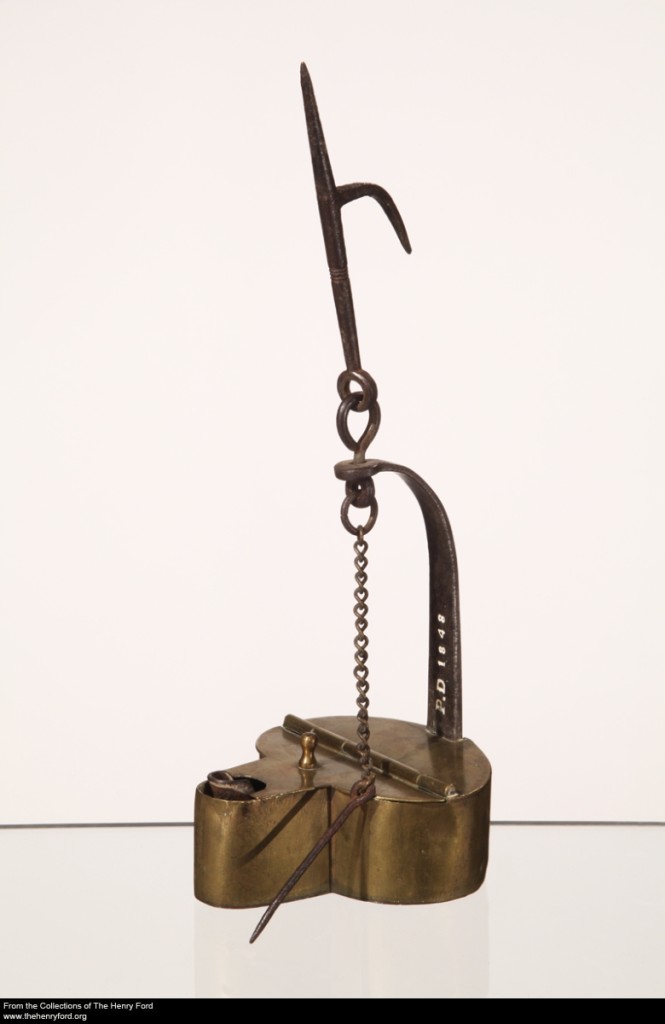My En-light-ening Internship at The Henry Ford

I began my internship with Charles Sable, Curator of Decorative Arts, in September of 2011. My assignment: to educate myself on the history of American lighting, research the lighting collection at The Henry Ford, and help to prepare for a visit of four antique lighting clubs that was scheduled for October of 2012.
I was excited for this opportunity; I enjoy research and was curious to see what was in the collection. As I began to learn the history of lighting and understand fuel sources and mechanics, I quickly found the breadth of the project was far greater than I had initially imagined! My preliminary research took about four months; I then began combing through some 7,000 lighting-related objects in the collection to select appropriate examples to present to the lighting collectors. This was done by searching the Henry Ford Museum’s collections management system.
To better understand the lighting collection at The Henry Ford, it's important to know its history, which can be traced back nearly 100 years, when Henry Ford first began collecting in the 1920s. During Ford’s creation of a museum that would “reproduce American life as lived,” (Simands, William A. & Stokes, Frederick A. Henry Ford and Greenfield Village. New York, p. 117) his agents scanned the country for objects that represented the development of the American experience. He was passionate about technological innovations of all kinds, with an interest in the evolution of lighting and the development of electricity, influenced by his close friendship with and admiration for Thomas Edison. This led him to acquire a substantial collection of lighting objects. Though some examples were peculiar and unique, many were rather conventional. These objects represent the technologies of their time period, as Americans searched for the most efficient lighting options.


The origin of much of the collection is difficult to pinpoint. Many objects were acquired before 1940 and were not documented the way objects are today. Luckily, Henry Ford kept the receipts for many of his purchases. These records provide clues that indicate Ford initially began collecting chronologically. He started with the oldest forms of lighting, such as candlesticks and rushlights, and by the 1930s was collecting gasoline-fueled lighting. The initiative to collect lighting ebbed after Ford’s death in 1947, but picked back up again in the 1960s and 1970s under the curatorship of Carleton Brown.
Though the collection was acquired in many stages, its significance is clear: it represents the evolution of lighting, and the search for a fuel that would burn brightly, was safe to use, easily accessible, and affordable.

Working chronologically, as Henry Ford did when assembling the collection, I sorted the objects into categories. The process of selecting those that would be shown to the visiting collectors then began. Working with two representatives from the groups, Charles and I spent several days going through the collection determining which objects would make the cut. The collectors were interested in unique examples, patent models, and rare pieces. After careful consideration, 25 objects were selected, and we ended up with some very interesting and unique picks!

During the weekend of Oct. 12, 2012, the four organizations (the Rushlight Club, The Historical Lighting Society of Canada, The Night Light Club, and the Fairy Lamp Club) visited The Henry Ford. They toured Henry Ford Museum and Greenfield Village to see the lighting on display, and were able to examine the 25 objects we selected. It was certainly a rewarding experience for everyone involved!
Though much of the lighting collection is not currently on display, visitors to the museum can see lighting examples in the "Made in America" and "Fully Furnished" exhibits, as well as inside many of the homes in Greenfield Village. All the objects chosen to show the collectors have been digitized for public viewing; for the remaining objects not shown here, take a look at our online collections site. You can see the artifacts listed here and more!
By Melanie Parker
technology, decorative arts, furnishings, by Melanie Parker, lighting


Facebook Comments